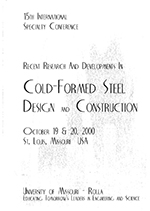Session Dates
19 Oct 2000
Abstract
Presented in this paper are the results of a recent study carried out at the University of Waterloo on the performance of residential floors supported by cold-formed steel C-section floor joists. Both static and dynamic tests were conducted on steel floors with different span lengths based on different design criteria. The purpose of the static tests was to evaluate the stiffuess and load sharing among the joists, and the purpose of the dynamic tests was to evaluate the dynamic characteristics such as frequencies of the floor systems. To identify the critical parameters that contribute to the control of floor vibration, tests were also carried out on floors without attached ceiling materials, with different bridging and blocking patterns, and with different support conditions. Test results are presented in comparison with the analytical results obtained from different design models.
Department(s)
Civil, Architectural and Environmental Engineering
Research Center/Lab(s)
Wei-Wen Yu Center for Cold-Formed Steel Structures
Meeting Name
15th International Specialty Conference on Cold-Formed Steel Structures
Publisher
University of Missouri--Rolla
Document Version
Final Version
Rights
© 2000 University of Missouri--Rolla, All rights reserved.
Document Type
Article - Conference proceedings
File Type
text
Language
English
Recommended Citation
Xu, L.; Ling, Z.; Xie, W. C.; and Schuster, R. M., "Dynamic Behaviour of Floors with Cold-formed Steel Joists" (2000). CCFSS Proceedings of International Specialty Conference on Cold-Formed Steel Structures (1971 - 2018). 2.
https://scholarsmine.mst.edu/isccss/15iccfss/15iccfss-session7/2
Dynamic Behaviour of Floors with Cold-formed Steel Joists
Presented in this paper are the results of a recent study carried out at the University of Waterloo on the performance of residential floors supported by cold-formed steel C-section floor joists. Both static and dynamic tests were conducted on steel floors with different span lengths based on different design criteria. The purpose of the static tests was to evaluate the stiffuess and load sharing among the joists, and the purpose of the dynamic tests was to evaluate the dynamic characteristics such as frequencies of the floor systems. To identify the critical parameters that contribute to the control of floor vibration, tests were also carried out on floors without attached ceiling materials, with different bridging and blocking patterns, and with different support conditions. Test results are presented in comparison with the analytical results obtained from different design models.



